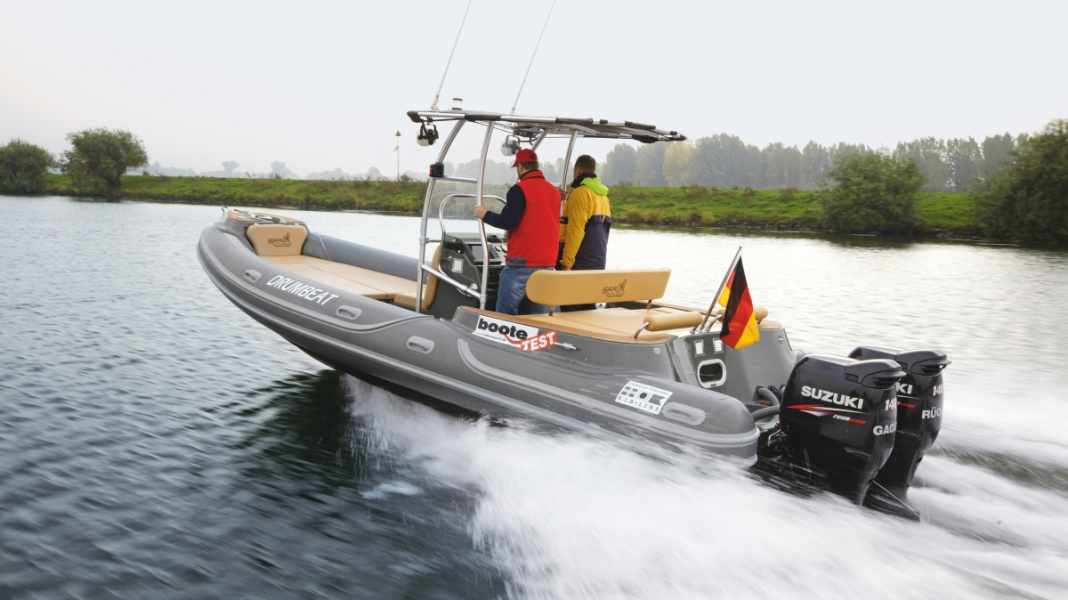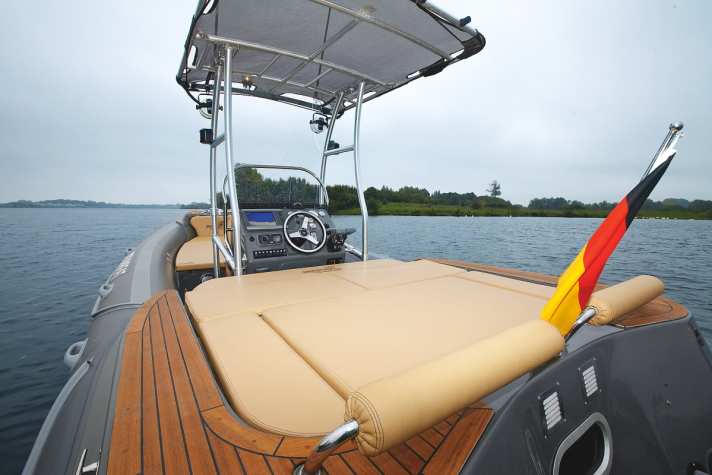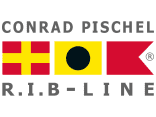

The boat pictured replaced the MV 780 in Conrad Pischel's delivery programme in October 2012. The hull and support hoses are still manufactured in Italy. The construction method has also been retained: the fixed hull of the RIB is manufactured as a sandwich construction using a vacuum process. In this way, a more even mixing ratio of resin and glass fibre fabric is achieved, which ensures a lower weight compared to conventional construction methods while maintaining the same strength. According to the manufacturer, the standard boat weighs 990 kg, but without engine and optional equipment. Ready to sail with the equipment ordered by the owner and our test engine, two 140 hp Suzuki outboards, the MV 800 weighs a good 1700 kg.

Proud people are allowed on board






This means that at least a trailer in the 2200 kg class is required for overland transport, and a 2500 kg trailer would be even better. At this weight, SUVs and other larger all-wheel drive vehicles can be considered as towing vehicles. The maximum width of the boat is also not insignificant for transport on the road. The permit-free upper limit is 2.55 metres. To get below this value, the air must be let out of the six chambers of the MV 800's carrying tube and the whole thing secured with tensioning straps.
The Pischel MV 800 is CE-categorised and can be used for excursions outside coastal waters. The maximum number of people on the test boat was an impressive 20, with space for passengers in the spacious bow and stern seating areas as well as in the seating area in front of the driving position.
At least 200 hp at the mirror
On our test boat, as already mentioned, two Suzuki outboards with 140 hp each provide propulsion and quickly bring the RIB into planing speed - with a brief loss of foresight due to the rising bow. If you leave the trim setting in and accelerate from displacement to planing speed, this process takes considerably longer and the view forwards is blocked by the nose of the boat for correspondingly longer. The shipyard states that the maximum permitted engine power is 300 hp. When asked about the smallest engine on offer for the MV 800, Conrad Pischel says: "Anything smaller than a 200 should not be fitted to the transom."
With the Suzukis installed, we were able to log just under 42 knots on the rev counter with the double lever shift to "full ahead" and 6100 rpm. The fuel consumption at this speed is 4.22 l/sm for both engines. With one filling of the standard 280-litre fuel tank, distances of 56 nm can be covered before the 15 % reserve is reached.
Optional additional tank for longer ranges
Volume levels: The "voices" of the two outboards are clearly audible at the helm. Quieter, more economical, but also slower, you are travelling at 20 knots, which is also the most economical planing speed. The rev counter shows around 3500 rpm and the noise level is pleasantly low at 79 dB/A.
We were able to calculate a range of 88 nm before refuelling if you want to keep the reserve. For longer ranges, there is a 120-litre additional tank on the options list, which can be stored in the bow storage compartment when ordered.
Spray only lands on the windscreen
If you are travelling over the waves of other pleasure craft or commercial vessels at a low speed, the RIB-Line MV 800 glides effortlessly over them without rocking much. Even at higher speeds, there is no feeling of insecurity on board the rigid-hull inflatable boat. The spray created when the hull is gently lowered is channelled far away from the boat at a shallow angle by the support hose. If spray does come over, it only lands on the windscreen of the test boat, which is attached to the tower.
When cornering at speed, the aircraft should always be trimmed all the way to the transom to prevent the propellers from ventilating. So you can go round in endless circles. The MV 800 also shows its best side on the imaginary slalom course. In other words, the hull runs cleanly according to the skipper's steering commands without rocking sideways in the centre of the bend or tilting over its longitudinal axis. Accordingly, the boat conveys a safe driving behaviour
A properly dimensioned compass
The steering position features a tidy instrument panel with analogue Suzuki engine displays. The latter can be viewed while sitting on the well-padded bench as well as standing up and the steering wheel can be operated. The rocker switches for the electrical systems are also within easy view and operating range. The standard and well-dimensioned compass helps with navigation. The double rubbing strake, which offers good protection when mooring, matches the size of the boat. The RIB-Line MV 800 can be moored using lines on the handles and the three mooring cleats in the bow and stern area.
The standard scope of delivery includes cushions for the bow and stern sun loungers, hydraulic steering, one electric and one manual bilge pump, gas pressure dampers on the hatches of the storage compartments, navigation lighting with BSH certification, shower with 80-litre water tank and pump, telescopic bathing ladder and GRP anchor davit with roller and anchor winch preparation.
Conclusion
The RIB-Line MV 800 from Conrad Pischel showed good to very good handling characteristics in our test. We also had little to criticise in terms of workmanship. What the tester did not like was the narrow passageway to the bow, which was slightly obstructed by the tower (not standard).
Technical data
Pischel R.I.B.-Line MV 800
- Shipyard: Conrad Pischel Boatbuilding
- Type designation: Pischel R.I.B.-Line MV 800
- CE category: A - High seas
- Length: 8,00 m
- Width: 2,90 m
- Displacement: 0,00 t
- Price: 54.303,00 €


